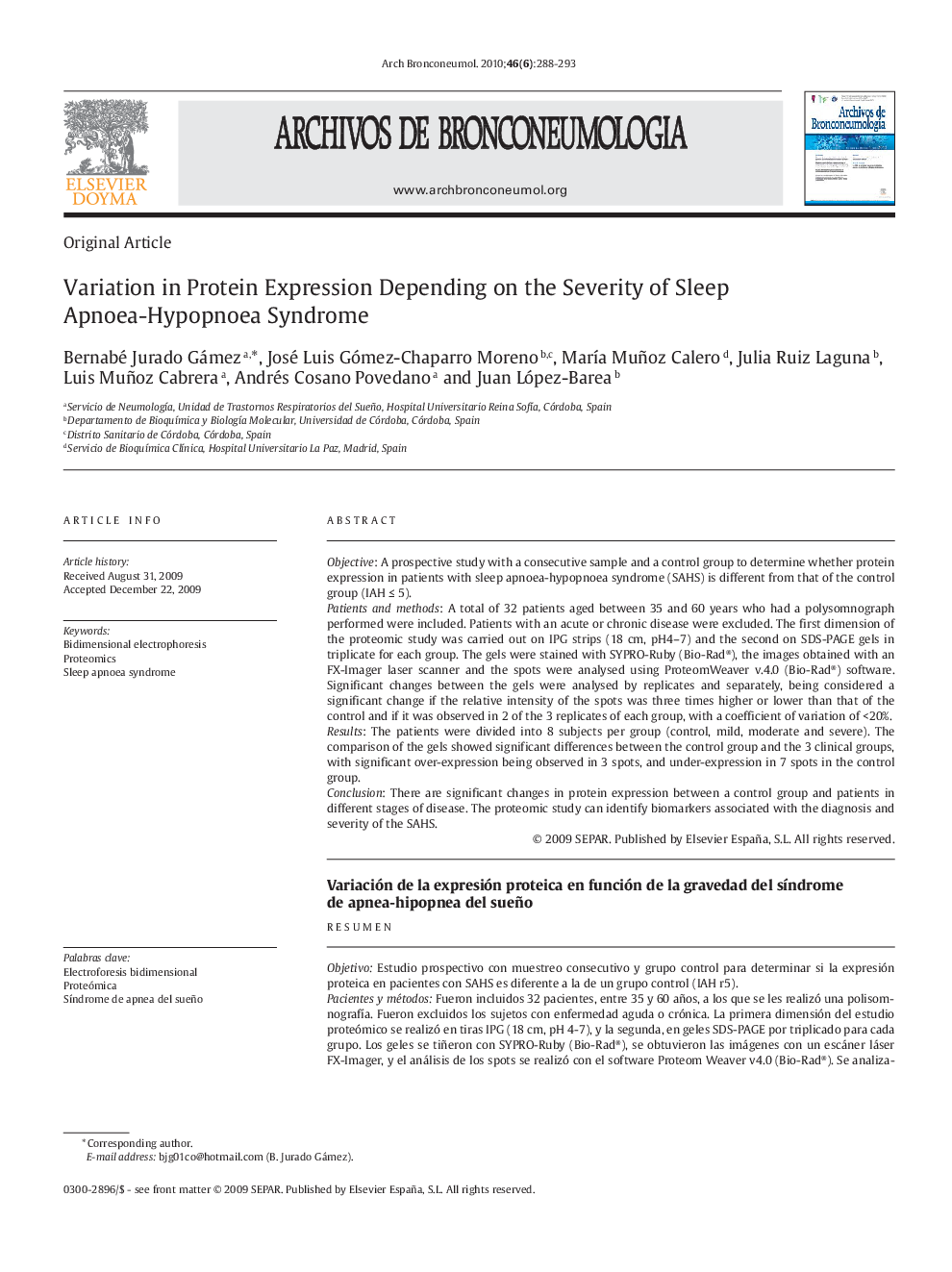| Article ID | Journal | Published Year | Pages | File Type |
|---|---|---|---|---|
| 4206011 | Archivos de Bronconeumología (English Edition) | 2010 | 6 Pages |
ObjectiveA prospective study with a consecutive sample and a control group to determine whether protein expression in patients with sleep apnoea-hypopnoea syndrome (SAHS) is different from that of the control group (IAH ≤ 5).Patients and methodsA total of 32 patients aged between 35 and 60 years who had a polysomnograph performed were included. Patients with an acute or chronic disease were excluded. The first dimension of the proteomic study was carried out on IPG strips (18 cm, pH4–7) and the second on SDS-PAGE gels in triplicate for each group. The gels were stained with SYPRO-Ruby (Bio-Rad®), the images obtained with an FX-Imager laser scanner and the spots were analysed using ProteomWeaver v.4.0 (Bio-Rad®) software. Significant changes between the gels were analysed by replicates and separately, being considered a significant change if the relative intensity of the spots was three times higher or lower than that of the control and if it was observed in 2 of the 3 replicates of each group, with a coefficient of variation of <20%.ResultsThe patients were divided into 8 subjects per group (control, mild, moderate and severe). The comparison of the gels showed significant differences between the control group and the 3 clinical groups, with significant over-expression being observed in 3 spots, and under-expression in 7 spots in the control group.ConclusionThere are significant changes in protein expression between a control group and patients in different stages of disease. The proteomic study can identify biomarkers associated with the diagnosis and severity of the SAHS.
ResumenObjetivoEstudio prospectivo con muestreo consecutivo y grupo control para determinar si la expresión proteica en pacientes con SAHS es diferente a la de un grupo control (IAH r5).Pacientes y métodosFueron incluidos 32 pacientes, entre 35 y 60 años, a los que se les realizó una polisomnografía. Fueron excluidos los sujetos con enfermedad aguda o crónica. La primera dimensión del estudio proteómico se realizó en tiras IPG (18 cm, pH 4-7), y la segunda, en geles SDS-PAGE por triplicado para cada grupo. Los geles se tiñeron con SYPRO-Ruby (Bio-Rad(), se obtuvieron las imágenes con un escáner láser FX-Imager, y el análisis de los spots se realizó con el software Proteom Weaver v4.0 (Bio-Rad(). Se analizaron los cambios significativos entre los geles agrupados por réplicas y por separado, considerándose un cambio significativo si la intensidad relativa en los spots fue superior o inferior en 3 veces a la del control y se observó en 2 de las 3 réplicas de cada grupo con un coeficiente de variación o 20%.ResultadosLos pacientes fueron divididos en 8 sujetos por grupo (control, leve, moderado y grave). La comparación de los geles constató diferencias significativas entre el grupo control y los 3 grupos clínicos, observándose 3 spots con sobreexpresión significativa y 7 spots subexpresados respecto al grupo control.ConclusiónExisten cambios significativos en la expresión protéica entre un grupo control y pacientes en distintos estadios de enfermedad. El estudio proteómico puede identificar biomarcadores relacionados con el diagnóstico y gravedad del SAHS.
